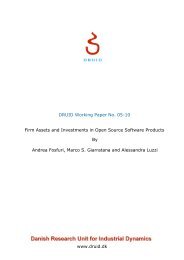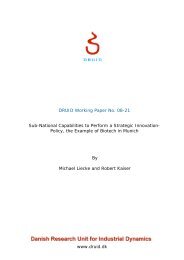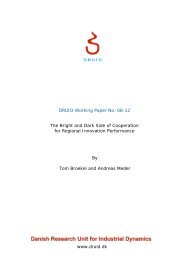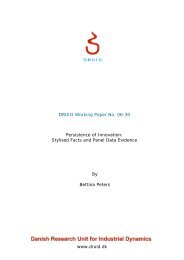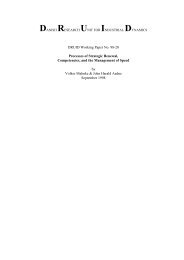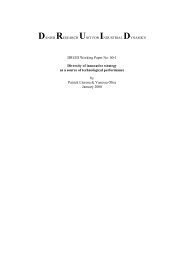danish research unit for industrial dynamics druid working paper no ...
danish research unit for industrial dynamics druid working paper no ...
danish research unit for industrial dynamics druid working paper no ...
You also want an ePaper? Increase the reach of your titles
YUMPU automatically turns print PDFs into web optimized ePapers that Google loves.
37increased their internal level of competence (cases of Mercedes and Kuka, PSA and RenaultAutomation, Fiat and Comau, Mercedes and Comau, Citröen and Comau). PSA has <strong>for</strong>example tried to help Renault Automation to absorb some competence in electric trajectoryby <strong>working</strong> with its producer in designing electrical robots and in sophisticated optoelectronicsprojects. PSA has also experimented the first electrical robot produced byRenault Automation in 1985 and has generated an important feed-back <strong>for</strong> improving thedominant design. From the other side, PSA has benefited from considerable in<strong>for</strong>mation onthe automative process (simplification on the line <strong>for</strong> bringing less complexity). Thelearning dynamic has explored new paths inside the electrical and opto-electronic trajectoryand at the same time has exploited new ideas <strong>for</strong> improving the technical solutions createdand <strong>for</strong> implementing them in a more realistic way (the laser Yag solution <strong>for</strong> assemblyrequired some important simplifications in order to be robust e<strong>no</strong>ugh on the line).Agreements with Comau (in the cases of Fiat, Mercedes and Citroën) show a similardynamic of the mutual benefits of cooperation with an in<strong>no</strong>vative dynamic characterised byboth exploitation and exploration. Comau begun its in<strong>no</strong>vative project with Fiat and hascreated the Robogate, a major in<strong>no</strong>vation in the robotic sector. This creation is in fact anautomative product integrating robots and various pieces of equipment on the line. Withoutimportant requirements coming from its user and a high level of learning by doing, Comauwould have <strong>no</strong>t been able to create such a successful piece of equipment in <strong>for</strong>eign markets.This project, patented at the beginning of the 80's, was trans<strong>for</strong>med <strong>for</strong> new plantconfiguration at the beginning of the 90's. Automobile firms needed more flexibleequipment and redeployable processes. Rationalisation in this sector required flexible linesadapted to small batches which could be easily trans<strong>for</strong>med according to user needs. Thisequipment also needed to be reconverted in others plants. The"Robogate" was <strong>no</strong>t flexiblee<strong>no</strong>ugh. That the reason why Mercedes and Comau created a new line benefiting from bothcompetencies (the competencies of Mercedes in flexible automative pocess and thecompetence of Comau in designing equipment including robots). This process called"Rotogate", patented in 1991, has been recreated with other users according theiridiosyncratic needs. Comau has developed an internal competence allowing the firm totrans<strong>for</strong>m and to combine its specific equipment with different backgrounds of k<strong>no</strong>wledge(the case of Citroën and Comau illustrates this combinative capacity). Comau proposes ageneral methodology flexible e<strong>no</strong>ugh <strong>for</strong> being adapted to user needs. This helps it to



